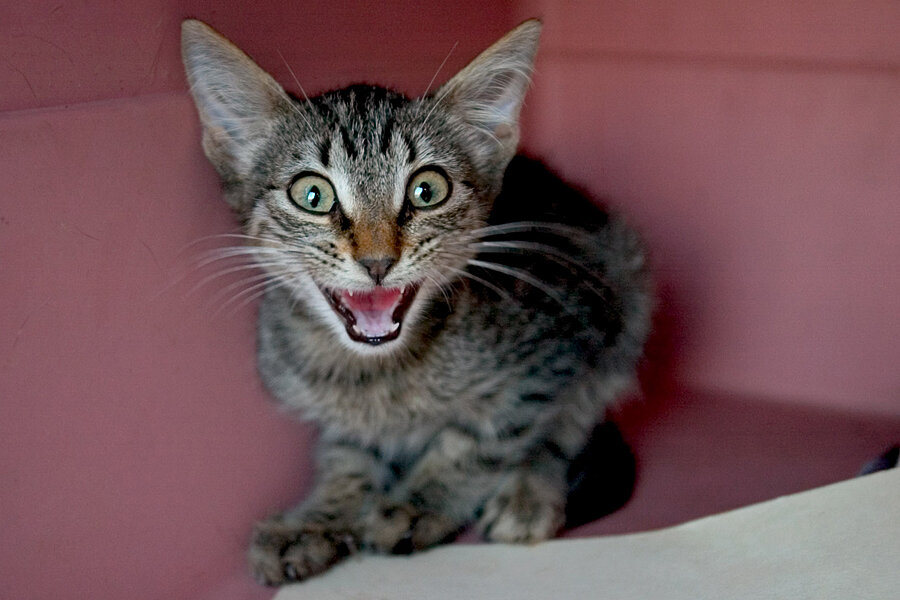Physicists scoop information from Schrödinger's cat box
Loading...
Scientists in the United States and Scotland say they have greatly improved a method of making direct measurements of quantum states without permanently altering them.
In a paper published in the current issue of the scientific journal Nature Communications and titled "Direct measurement of a 27-dimensional orbital-angular-momentum state vector," a team of physicists led by the University of Rochester's Mehul Malik describe how they circumvented a basic principle of uncertainty that requires that some states of a quantum system must be understood poorly if other states are to be understood well.
Determining a quantum state, such as the position of an electron or the momentum of a photon, is tricky, to say the least. That's because subatomic particles behave nothing at all like billiard balls, orbiting moons, or any other kind of object with which we humans are remotely familiar.
A photon, for instance, sometimes acts like a wave, diffracting, interfering, and scattering, as all good waves ought to. Yet sometimes it will also behave like a particle, for instance by bashing into an electron or by traveling with ease through a vacuum.
According to our current understanding, things at the quantum scale can exist simultaneously in these two modes, both as localized particles, with distinct measurable states, and as spread-out probabilistic waves, with multiple contradictory states.
One consequence of this "wave-particle duality" is that it imposes a fundamental limit on how much we can know about the universe. An unobserved electron, say scientists, exists as a wave of mutually contradictory states. As the German physicist Werner Heisenberg first pointed out in 1927, taking a measurement of one state, say, the electron's position, and you irreversibly alter its momentum, and vice versa. In the parlance of quantum physicists, the "wavefunction" of a system's probabilities "collapses" into a specific state when you observe it.
If the quantum-mechanical model sounds bizarre, that's because it is. And yet it is able to predict, with terrific accuracy, the behavior of the tiniest known constituents of the cosmos.
One of this model's original architects, the Austrian physicist Erwin Schrödinger, vividly pointed out a very odd consequence of this interpretation.
Imagine, wrote Schrödinger in 1935, a cat sealed for one hour inside a box along with device consisting of a radioactive substance, a Geiger counter, and a flask of poison gas. When the Geiger counter registers a radioactive decay particle, it causes the poison to be released into the box, killing the cat.
But there's only a 50 percent chance that the substance will trigger the Geiger counter within the hour. So the cat has an even chance of getting out of the box alive.
The cat's life depends entirely on the behavior of a radioactive decay particle, which, if our current understanding of the universe is correct, simultaneously exists in multiple states. As long as it remains unobserved, the particle is both striking and not striking the tube in the Geiger counter, which means that the poison is both being released and not being released, and that the cat is both dead and living.
Open the box and the particle's wavefunction collapses, and the cat's indeterminate mortal state resolves into one in which it is either alive or not.
If mutually exclusive contradictory states can exist in the quantum world, asked Schrödinger's thought experiment, why don't they exist in the observable world? At what scale does reality stop acting like a wavefunction and start acting like, well, reality?
Since Schrödinger's initial attempt to distress cat people worldwide, physicists have sought to circumvent this quantum uncertainty, to peek into the Schrödinger's box and have a look at the cat, but without collapsing the decay particle's wavefunction and triggering an outcome.
The most popular way to do this is called quantum tomography, and involves taking a lots and lots of different measurements of identical quantum systems (think lots of cats in lots of boxes) and then probabilistically reconstructing the system's states. But this technique doesn't avoid collapsing the wavefunction (think lots of poisoned cats).
In 2011 scientists with Canada's National Research Council developed a faster, more direct alternative to quantum tomography, one that preserves the quantum systems in their unobserved forms. The key is to make a "weak measurement" of one state of the system, in this case the orbital angular momentum of a photon, without irrevocably disturbing it.
"It is sort of like peeking into the box to see if Schrödinger's cat is alive, without fully opening the box," said Malik in a press release from the University of Rochester. "The weak measurement is essentially a bad measurement, which leaves you mostly uncertain about whether the cat is alive or dead. It does, however, give partial information on the health of the cat, which when repeated many times can lead to near certain information as to whether the cat is alive or dead."
The National Research Council team used their technique to measure the polarization of photons. Malik's team's study showed that this technique is possible for studying "a discreet, high-dimensional system."








